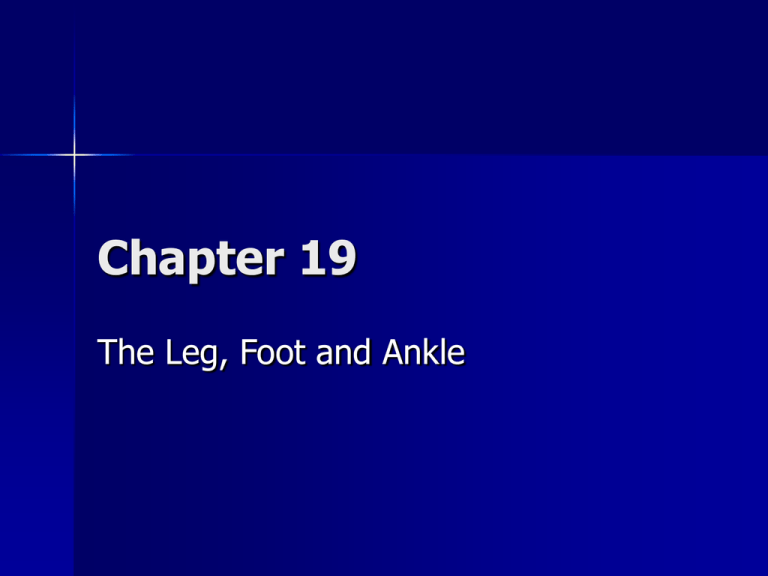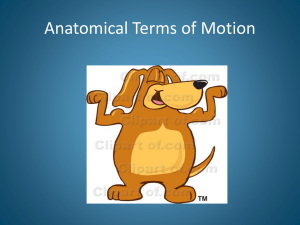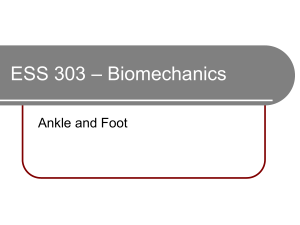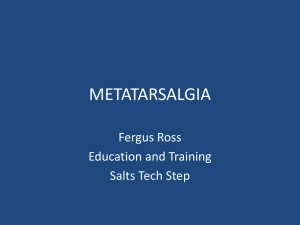The Ankle and Foot
advertisement

Chapter 19 The Leg, Foot and Ankle Overview The ankle and foot is a complex structure comprised of 28 bones (including 2 sesamoid bones) and 55 articulations (including 30 synovial joints), interconnected by ligaments and muscles In addition to sustaining substantial forces, the foot and ankle serve to convert the rotational movements that occur with weight bearing activities into sagittal, frontal, and transverse movements Anatomy Anatomically and biomechanically, the foot is often subdivided into: The rearfoot or hindfoot (the talus and calcaneus) The midfoot (the navicular, cuboid and the 3 cuneiforms) The forefoot (the 14 bones of the toes, the 5 metatarsals, and the medial and lateral sesamoids) Anatomy Distal Tibiofibular Joint – Classified as a syndesmosis – Consists of a concave tibial surface and a convex or plane surface on the medial distal end of the fibula Anatomy The talocrural (ankle) joint Formed between the saddle-shaped talus and the distal tibia Classified as a synovial hinge or a modified sellar joint Anatomy Subtalar (talocalcaneal) joint – The subtalar joint is a synovial, bicondylar compound joint consisting of two separate, modified ovoid surfaces with their own joint cavities (one male and one female) – This relationship ensures that the anterior and posterior aspects can move in opposite directions to each other during functional movements (while the anterior aspect is moving medially, the posterior aspect is moving laterally) Anatomy Talocalcaneal joint ligaments – A number of ligaments provide support to this joint, although some confusion exist in the descriptions and nomenclature of these ligaments The two superficial ligaments are the lateral and posterior talocalcaneal ligaments The deep ligaments include the interosseous, cervical, and axial ligaments, often referred together as the interosseous ligaments Anatomy The midtarsal joint complex – Consists of the talonavicular and calcaneocuboid articulations The talonavicular joint is classified as a synovial, compound, modified ovoid joint – Formed by components of the talus, navicular, calcaneus and plantar calcaneonavicular (spring) ligament The calcaneocuboid joint is classified as a simple, synovial modified sellar joint Anatomy Ligaments of the mid-tarsal joints – A number of ligaments help provide support to this region: The spring ligament (plantar calcaneonavicular) connects the navicular bone to the sustentaculum tali on the calcaneus The ligaments of the calcaneocuboid joint include the long plantar ligament and a portion of the bifurcate ligament dorsally Anatomy The cuneonavicular joint – Classified as a compound, synovial, modified ovoid joint Anatomy Intercuneiform and Cuneocuboid Joints – These joints are classified as compound, synovial, modified ovoid joints Anatomy Cubometatarsal joint – When considered alone, this joint is classified as a compound modified ovoid, synovial joint Anatomy The cubonavicular joint – Classified as a syndesmosis, or a plane surfaced joint Anatomy Intermetatarsal joints – The first intermetatarsal joint is classified as a simple, synovial, modified ovoid joint, while the 2nd, 3rd and 4th are classified as compound joints Anatomy The metatarsophalangeal (MTP) joints – Classified as simple, synovial, modified ovoid joints Anatomy The interphalangeal (IP) joints – Classified as simple, synovial modified sellar joints Anatomy Plantar fascia/aponeurosis – The plantar fascia is the investing fascial layer of the plantar aspect of the foot that originates from the os calcis and inserts through a complex network to the plantar forefoot – A tough, fibrous layer, composed histologically of both collagen and elastic fibers – Three portions Anatomy Plantar fascia/aponeurosis – With standing and weightbearing, the plantar fascia plays a major role in the support of the weight of the body by virtue of its attachments across the longitudinal arch. Anatomy Retinacula – There are four important ankle retinacula, which function to tether the leg tendons as they cross the ankle to enter the foot Anatomy The extrinsic muscles of the foot – Can be divided into anterior, posterior superficial, posterior deep, and lateral compartments Anatomy The extrinsic muscles of the foot – Anterior compartment This compartment contains the dorsiflexors (extensors) of the foot. These include the tibialis anterior, extensor digitorum longus, extensor hallucis longus, and peroneus tertius – Posterior superficial compartment This compartment, located posterior to the interosseous membrane, contains the calf muscles which plantarflex (flex) the foot. These include the gastrocnemius, soleus, and the plantaris muscle Anatomy The extrinsic muscles of the foot – Posterior deep compartment This compartment contains the flexors of the foot. These muscles include the posterior tibialis, flexor digitorum longus, and flexor hallucis longus – Lateral compartment This compartment contains the peroneus longus and brevis Anatomy The intrinsic muscles of the foot – Subdivided into 4 layers 1st layer: – Abductor hallucis – Abductor digiti minimis – Flexor digitorum brevis 2nd layer – Flexor digitorum accessorius (quadratus plantae) – Lumbricales Anatomy The intrinsic muscles of the foot – 3rd layer Flexor hallucis brevis Flexor digiti minimis Adductor hallucis – 4th layer Dorsal interossei Plantar interossei Anatomy The dorsal intrinsic muscles of the foot – Consist of the extensor hallucis brevis (EHB) and extensor digitorum brevis (EDB) muscles Anatomy Arches of the foot – There are 3 main arches: The medial longitudinal The lateral longitudinal The transverse Anatomy Neurology – The saphenous nerve, the largest cutaneous branch of the femoral nerve, provides cutaneous distribution to the medial aspect of the foot – The sciatic nerve provides the sensory and motor innervation for the foot and leg It divides into the common peroneal and tibial nerves. The common peroneal nerve in turn divides into the superficial peroneal, deep peroneal nerves. The tibial nerve divides into the sural, medial calcaneal, medial plantar, and lateral plantar nerves Anatomy Vascular supply – Two branches of the popliteal artery, the anterior tibial artery and the posterior tibial artery, form the main blood supply to the foot Biomechanics Terminology – Motions of the leg foot and ankle consist of single plane and multi-plane movements. The single plane motions include: The frontal plane motions of inversion and eversion The sagittal plane motions of dorsiflexion and plantarflexion The horizontal plane motions of adduction and abduction Biomechanics A triplane motion describes a movement about an obliquely oriented axis through all three body planes. Triplanar motions occur at the talocrural, subtalar, and midtarsal, joints, and at the first and fifth rays. Pronation and supination are considered triplanar motions Biomechanics Pronation – The three body plane motions in pronation are abduction in the transverse plane, dorsiflexion in the sagittal plane, and eversion in the frontal plane Biomechanics Supination – The three body plane motions in supination are a combined movement of adduction, plantarflexion, and inversion Biomechanics Proximal tibiofibular joint – Because of the interaction between the proximal and distal tibiofibular joints with the knee and the ankle function, the clinician should always evaluate the functional mobility of both these complexes when treating one or the other Biomechanics Talocrural Joint – The primary motions at this joint are dorsiflexion and plantar flexion, with a total range of 70-80° – Theoretically, the capsular pattern of the ankle joint is more restriction of plantarflexion than dorsiflexion, although clinically this appears to be reversed – The close-packed position is weight-bearing dorsiflexion, while the open-packed position is midway between supination and pronation. Biomechanics The subtalar joint – Subtalar joint supination and pronation are measured clinically by the amount of calcaneal or hindfoot inversion and eversion – In normal individuals, there is an inversion to eversion ratio of 2:3 to 1:3, which amounts to approximately 20° of inversion and 10° of eversion Biomechanics Subtalar joint – The capsular pattern of this joint varies. In chronic arthritic conditions, there is an increasing limitation of inversion, but with traumatic arthritis, eversion appears most limited clinically – The close-packed position for this joint is full inversion, while the open-packed position is inversion/plantarflexion Biomechanics The midtarsal joint complex – Provides the foot with an additional mechanism for raising and lowering the arch, and to absorb some of the horizontal plane tibial motion that is transmitted to the foot during stance – The talonavicular joint two degrees of freedom: plantar flexion/dorsiflexion and inversion/eversion, with motion occurring around a longitudinal and oblique axis, both of which are independent of each other The capsular pattern is a limitation of dorsiflexion, plantar flexion, adduction and internal rotation The close packed position is pronation The open packed position is midway between extremes of range of motion Biomechanics The midtarsal joint complex – The capsular pattern for the calcaneocuboid joint is a limitation of dorsiflexion, plantar flexion, adduction and internal rotation Biomechanics The cuneonavicular joint – Has one to two degrees of freedom: plantar/dorsiflexion, inversion/eversion – The capsular pattern is a limitation of dorsiflexion, plantar flexion, adduction and internal rotation – The close-packed position is supination – The open-packed position is considered to be midway between the extremes of range of motion Biomechanics Intercuneiform and Cuneocuboid Joints – Due to their very plane curvature, these joints have only one degree of freedom: inversion/eversion – The close packed position for these joints is supination – The open packed position is considered to be midway between extremes of range of motion Biomechanics Cubometatarsal Joint – The capsular pattern of this joint is a limitation of dorsiflexion, plantar flexion, adduction and internal rotation – The close-packed position is pronation. – The open-packed position is considered to be midway between extremes of range of motion Biomechanics Cubonavicular Joint – The close-packed position for this joint is supination – The open-packed position is midway between extremes of range of motion Biomechanics Intermetatarsal Joints – The close-packed position for these joints is supination – The open-packed position is midway between extremes of range of motion Biomechanics Metatarsophalangeal Joints – The MTP joints have two degrees of freedom: flexion/extension and abduction/adduction. – Range of motion of these joint is variable, ranging from 40° to 100° dorsiflexion (with a mean of 84°), 3° to 43° (mean, 23°) plantar flexion, and 5° to 20° varus and valgus – The closed-packed position for the MTP joints is full extension – The capsular pattern for these joints is variable, with more limitation of extension than flexion – The open-packed position is 10º of extension. Biomechanics 1st Metatarsophalangeal Joint – The function of the great toe is to provide stability to the medial aspect of the foot, and to provide for normal propulsion during gait. Normal alignment of the 1st MTP joint varies between 5° varus and 15° valgus – The great toe is characterized by having a remarkable discrepancy between active and passive motion. Approximately 30° of active plantar flexion is present, and at least 50° of active extension, which can be frequently increased passively to between 70-90°. Biomechanics Interphalangeal (IP) Joints – Each of the IP joints has one degree of freedom: flexion/extension – The capsular pattern is more limitation of flexion than of extension – The close-packed position is full extension – The open-packed position is slight flexion Examination The examination is used to identify static and dynamic, structural or mechanical foot abnormalities The clinical diagnosis is based on an assessment of the changes in joint mobility and tissue changes at the foot and ankle, and the effect these have on the function of the remainder of the lower kinetic chain Examination History – The primary purposes of the history are to: Determine the severity of the condition Determine the area, nature and behavior of the symptoms Help determine the specific structure at fault Detect systemic conditions (collagen disease, neuropathy, radiculopathy, and vascular problems), or the presence of serious pathology Examination Systems Review – As symptoms can be referred distally to the leg, foot and ankle from a host of other joints and conditions, the clinician must be able to differentially diagnose from the presenting signs and symptoms – The cause of the referred symptoms may be neurological or systemic in origin. If a disorder involving a specific nerve root (L 4, L 5, S1, or S 2) is suspected, the necessary sensory, motor and reflex testing should be performed – Peripheral nerve entrapments, although not common, may also occur in this region and often go unrecognized Examination Systems Review – Systemic problems that may involve the leg, foot and ankle include diabetes mellitus (peripheral neuropathy), osteomyelitis, gout and pseudogout, sickle cell disease, complex regional pain syndrome, peripheral vascular disease, and rheumatoid arthritis Examination Observation – Observation of the lower extremity is extensive. It is extremely important to observe the entire kinetic chain when assessing the leg, foot, and ankle. Weight bearing and non-weight bearing postures of the foot are compared. – Observing the patient while they move from sit to stand, and walk to the treatment area, gives the clinician a sense of the patient’s functional ability in weight bearing, and provides the first opportunity for gait analysis. Examination Palpation – Careful palpation should be performed around the leg, foot, and ankle to differentiate tenderness of specific ligaments and other structures – Areas of localized swelling and ecchymosis over the ligaments on the medial or lateral aspects of the foot and ankle should be noted Examination Active and Passive Range of Motion – AROM tests are used to assess the patient’s willingness to move and the presence of movement restriction patterns such as a capsular on non-capsular pattern – General active range of motion of the foot and ankle in the non-weight bearing position is assessed first, with painful movements being performed last – In addition to the foot and ankle tests, the clinician should also assess hip and knee range of motion Examination Strength testing – Isometric tests are carried out in the extreme range, and if positive, in the neutral range – The straight plane motions of ankle dorsiflexion, plantar flexion, inversion and eversion are tested initially. Pain with any of these tests requires a more thorough examination of the individual muscles Examination Strength testing – The individual isometric muscle tests can give the clinician information about patterns of weakness other than from spinal nerve root or peripheral nerve palsies and can also help to isolate the pain generators – A painful weakness is invariably a sign of serious pathology, and depending on the pattern, could indicate a fracture or a tumor. However, if a single motion is painfully weak this could indicate muscle inhibition due to pain. Examination Strength testing – Weakness on isometric testing needs to be analyzed for the type: Increasing weakness with repeated contractions of the same resistance indicating a palsy Consistent weakness with repeated contractions which could suggest a deconditioned muscle, or a significant muscle tear), and the pattern of weakness (spinal nerve root, nerve trunk or peripheral nerve) Examination Passive articular mobility – Passive articular mobility tests assess the accessory motions available between the joint surfaces. These include tests of the joint glides, joint compression and joint distraction tests. As with any other joint complex, the quality and quantity of joint motion must be assessed to determine the level of joint involvement Examination Special tests – Special tests are merely confirmatory tests – Selection for their use is at the discretion of the clinician and is based on a complete patient history – The results from these tests are used in conjunction with the other clinical findings and should not be used alone to form a diagnosis – To assure accuracy with these tests, both sides should be tested for comparison Examination Neurological tests – Important neurological structures that pass through the ankle and terminate in the foot are the saphenous, superficial peroneal, deep peroneal, posterior and anterior tibial nerves, and the sural nerve – Symptoms can be referred to the foot and ankle from the L 4-S 2 nerve roots (sciatic) and from a host of non-neurological conditions Examination Neurological tests – Common reflexes tested in this area are the Achilles reflex (S 1-2), and the posterior tibial reflex (L 4-5) – The pathological reflexes (Babinski, and Oppenheim), tested when an upper motor neuron lesion is suspected Intervention Intervention Acute phase goals: – – – – – – – Decrease pain, inflammation and swelling Protect the healing area from re-injury Re-establish pain-free range of motion Prevent muscle atrophy Increase neuromuscular control Maintain fitness levels Patient to be independent with home exercise program Intervention Functional phase goals: – Restore normal joint kinematics – Attain full range of pain free motion – Improve neuromuscular control of the lower extremity in a full weight bearing posture on both level and uneven surfaces – Regain and improve lower extremity strength and endurance through integration of local and kinetic chain exercises Intervention








